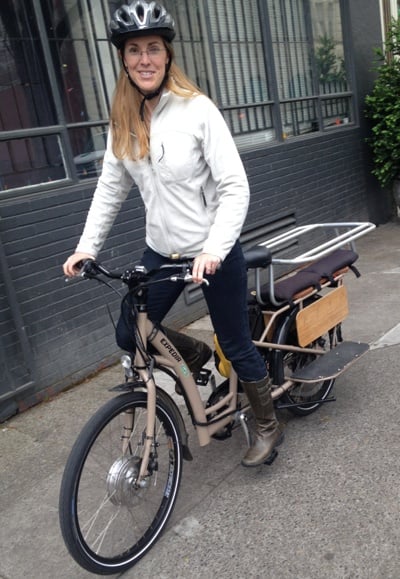A new poster summarizing research from a Portland State University scholar has some interesting factoids about electric bike users, but it doesn’t answer what’s becoming one of the biggest mysteries in American biking: why haven’t e-bikes taken off yet in the United States?
“If we can sell a lot of e-bikes in Germany, than we’ll sell a lot of e-bikes in the U.S. too over time. Yes, we love our cars, but Germans love their cars too.”
— Rob Kaplan, Currie Tech
In China, according to one estimate, 200 million people own e-bikes — that’d be 15 percent of the country’s population.
More recently, e-bikes have been rocketing across Europe. Rob Kaplan, VP of sales and marketing at Currie Technologies, a large developer and distributor of e-bikes under the iZip, eFlow, and Haibike brand names, said during an event in Portland last April that about 80,000 e-bikes are sold in the U.S. market per year. Compare that to Germany where 400,000 units are sold annually. In the pancake-flat Netherlands, e-bikes now represent 19 percent of new bike sales by quantity, even though they cost four times as much as a non-electric model; that’s how much Dutch people have come to love e-bikes.
Advertisement

to realize the potential of e-bikes.
(Photo: J. Maus/BikePortland)
Here in the United States, e-bike sales continue to grow rapidly, in part due to reasons illustrated in the graphic above. Kaplan of Currie Tech says their dealer sales are up 46% overall and up 286% year-to-date.
Locally, there are signs of growth too. If you’re heading north on Grand Avenue this month, you can admire a big billboard for Cynergy E-Bikes on Southeast Powell; in North Portland, the eBike Store recently moved to a larger location with expanded hours.

(Photo: J. Maus/BikePortland)
But even here, electric bikes are far from mainstream.
Currie points to several factors that might be keeping a cap on U.S. sales growth: acceptance, education, and infrastructure. Bike shop employees aren’t familiar with e-bikes and many of them aren’t exactly huge fans of the technology, says Currie, and that lack of enthusiasm spills over into their sales pitches. The market itself is also relatively uneducated about the latest in e-bike technology (“most people still confuse them with scooters,” he said). And then there’s the lack of bike-friendly infrastructure in the U.S., which is a problem for cycling growth in general.
But Currie is very optimistic about future growth. “If we can sell a lot of e-bikes in Germany,” he told a crowd of e-bike industry leaders at a talk hosted by Drive Oregon, “than we’ll sell a lot of e-bikes in the U.S. too over time. Yes, we love our cars, but Germans love their cars too.”
His other reasons for optimism include: aging demographics, re-urbanization, concerns about the environment, and improvements battery technology.
As companies keep working to crack the American e-bike code, the sort of market research being done by John MacArthur through OTREC at Portland State University will come in handy. For more on his research, read our story from last fall: The appeal of e-bikes: 5 facts from a new study.
Editor/Publisher Jonathan Maus contributed to this post.


